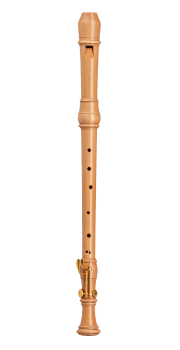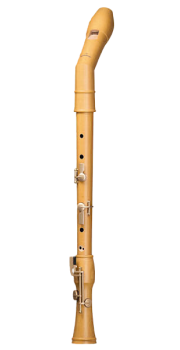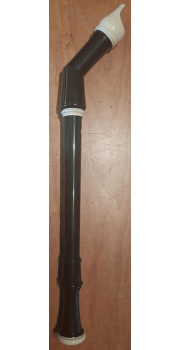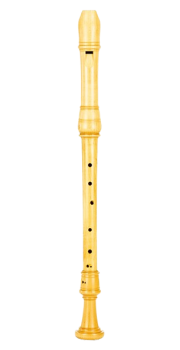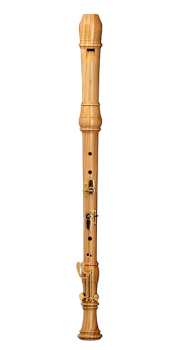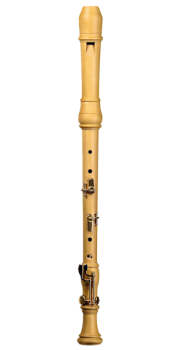No products
Prices are tax included
Filters
Please read all of this before buying a tenor!!!
Many players find it difficult to reach all the holes when playing tenor, especially for the smallest 2 fingers of the right hand. The tenor is by no means the largest recorder, but still it can involve finger stretches greater than on any of the larger bass instruments. Our experience over 25 y...
Please read all of this before buying a tenor!!!
Many players find it difficult to reach all the holes when playing tenor, especially for the smallest 2 fingers of the right hand. The tenor is by no means the largest recorder, but still it can involve finger stretches greater than on any of the larger bass instruments. Our experience over 25 years has shown that when a player encounters finger spacing problems, ninety nine times out of a hundred it will be on a tenor. These problems often result in either having to stop playing the tenor altogether, or having to upgrade to a knick or a comfort model - please choose carefully!!!
There is quite a bit of variation in finger hole position from one maker to another, and from one model to another. The chart below was prepared to try and show which ones will be easier. There are several factors involved: the distance between the holes is important, but another significant factor is whether the recorder is straight or has a bent head ("knick"). Knick tenors allow the right hand to hold the recorder in a higher position than with a straight instrument - the right hand is not stretching down so far and consequently a spacing that may actually be a little wider will still feel easier to reach on a knick instrument. Players that have problems with their right-hand wrist should strongly consider knick instruments.
The chart shows clearly that the use of split keys for C and C# doesn't automatically mean the right-hand little finger doesn't have to stretch so far. Many players assume that if they choose a model with C/C# keys they will have no problems, when in fact many of the most extreme little-finger stretches are actually on keyed instruments.
Often a player will have specific issues with one or two fingers. If this is the case, then you may need to focus more on comparing the measurements for the holes played by the problem fingers. In such cases the general ranking provided here might not be so relevant for your special circumstances.
In this chart the weights shown are a guide only - weight can vary within a particular model depending on which wood has been used.

A large range of tenor recorders made in a beautiful range of woods including pear, plum, satinwood, olive, rose, palisander, grenadilla, boxwood and cherrywood. Orpheus Music stocks tenor recorders from a variety of makers including Mollenhauer Recorders from Germany, Kung Recorders from Switzerland and Aulos, Yamaha and Zen-on Recorders from Japan. The tenor is a great ensemble instrument as well as a favoured recorder for contemporary compositions.
Reference: MOL-5431
Brand: Mollenhauer
Denner Tenor recorder (with double key) in cherrywood
Brilliant, expressive sound with a convincing charm.
Agile, quick response in all octaves: ideal for virtuosic music of any era.
Undercut finger holes: discover the particularly stable sounds of these instruments.
Visually impressive: finely crafted ornamental rings and a surface pleasingly finished with oil.
$1,541.00In StockReference: MOL-2446KC
Brand: Mollenhauer
Canta Knick Comfort Tenor Recorder (with four keys) in Pearwood
- Pearwood Tenor, baroque double hole, with four keys
- Canta, the joy of ensemble playing Versatile, reliable recorder ensemble with an homogenous sound, made of pearwood.
- Our Comfort Tenor makes playing easy: two additional keys reduce the stretch of the hand. G-key: The left ring finger no longer needs to be strained.
$1,650.00In StockReference: PG3-T/MN
Brand: Zen-on
Bressan Tenor in Maple
Tenor based on the designs of Bressan by Japanese maker Takeyama, produced by Zen-on.
Made from Maple Wood.
$1,158.00Out of stockReference: AU211K
Brand: Aulos
Knick Robin Tenor Recorder
- Standard Robin tenor with the head joint modified by Orpheus Music
- The closer hole spacing of the Robin combined with the knick head-joint make this the most affordable ergonomically friendly tenor
- Clear and gentle tone, with no key.
- Narrow mouthpiece, stream-lined shape,
$195.00Out of stockReference: TT442C
Brand: Takeyama
Takeyama Tenor Recorder in Cherrywood
Made from Cherry
Baroque fingering, double holes
Perfect intonation, easy to play across the range
Sound is warm and dark with a gentle beginning to the notes
A beautiful instrument for elegant shaping of phrasesNew Stock Early July 25
$1,861.00Out of stockReference: TT442-415BB
Brand: Takeyama
Takeyama Tenor Recorder 442-415Hz in Brazilian Boxwood
2 Bodies, interchangeable between Modern and Baroque pitches
Made from Brazilian Boxwood
Baroque fingering, double holes
Perfect intonation, easy to play across the range
Sound has both warmth and clarity
Performs well across a wide range of styles$2,381.00In StockReference: TT442BB
Brand: Takeyama
Takeyama Tenor Recorder in Brazilian Boxwood
Made from Brazilian Boxwood
Baroque fingering, double holes
Perfect intonation, easy to play across the range
Sound has both warmth and clarity
Performs well across a wide range of stylesNew Stock Early July 25
$1,861.00Out of stockReference: TT442M
Brand: Takeyama
Takeyama Tenor Recorder in Maple
Made from Maple
Baroque fingering, double holes
Perfect intonation, easy to play across the range
Sound has both warmth and clarity
Performs well across a wide range of styles$1,705.00In StockReference: TT415BB
Brand: Takeyama
Takeyama Tenor Recorder 415Hz in Brazilian Boxwood
Pitch: a = 415Hz
Made from Brazilian Boxwood
Baroque fingering, double holes
Perfect intonation, easy to play across the range
Sound has both warmth and clarity
Performs well across a wide range of styles$2,299.00Out of stockReference: MOL-2446C
Brand: Mollenhauer
Canta Comfort Tenor in Pearwood
Pearwood Tenor, baroque double hole, with four keys Canta, the joy of ensemble playing Versatile, reliable recorder ensemble with an homogenous sound, made of pearwood Our Comfort Tenor makes playing easy: two additional keys reduce the stretch of the hand. G-key: The left ring finger no longer needs to be strained. F-key: The right index finger stretches less, making the entire hand relax
$1,595.00In StockReference: MOL-5431C
Brand: Mollenhauer
Denner Comfort Tenor in Cherry
Brilliant, expressive sound with a convincing charm.
Agile, quick response in all octaves: ideal for virtuosic music of any era.
Undercut finger holes: discover the particularly stable sounds of these instruments.
Visually impressive: finely crafted ornamental rings and a surface pleasingly finished with oil.
$2,191.00Out of stockReference: MOL-5432C
Brand: Mollenhauer
Denner Comfort Tenor Recorder in Castello Boxwood
- Castello boxwood tenor, baroque double holes, with four keys.
- Denner - A wealth of sound from fine woods. A sophisticated ensemble based on original instruments by Jacob Denner (1681-1735) in Nuremberg and Copenhagen.
- Our Comfort Tenor makes playing easy: two additional keys reduce the stretch of the hand.
$2,074.00In Stock

